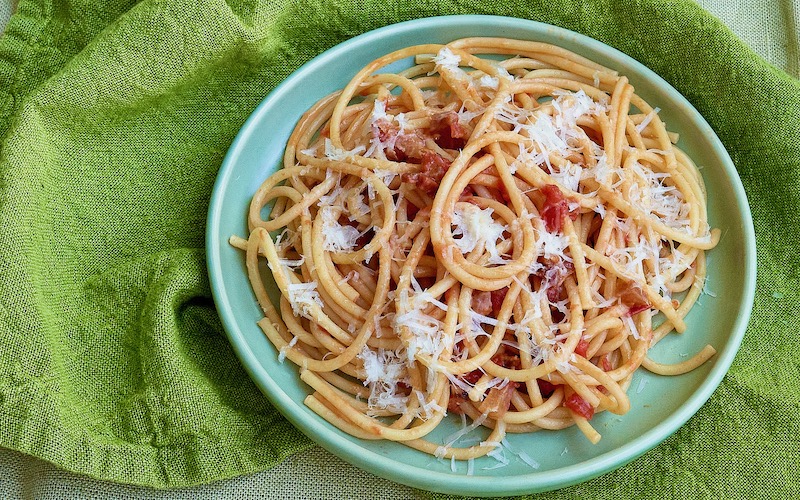

I love tomato, cheese and all things quick and easy, so I’m not sure why it took me so long to try my hand at bucatini all’Amatriciana, one of Italy’s classic pasta dishes. Perhaps it’s because guanciale (cured pork cheek) can be tricky to find – so when I discovered Salumi Australia’s guanciale in my local Harris Farm, I had no excuse. Amatrice, for which the sauce is named, is a mountain town about 2 hours west of Rome. Before tomatoes were introduced to Italy, locals simply dressed spaghetti with sheep cheese and guanciale. This ‘in bianco’ sauce, called alla gricia, is still popular in central Italy. Meanwhile, the version with tomato and hollow bucatini has also become one of the five classic Roman pasta dishes. Regardless of where it’s made, a good pecorino is essential, Amatrice has its own, while in Rome and Australia authentic Pecorino Romano is best. Enjoy bucatini all’Amatriciana with a glass of complex, savoury Dal Zotto La Nebbia Col Fondo naturally sparkling nebbiolo, and take a vicarious Roman holiday! See the video below for all you need to know about cooking pasta perfectly.
Serves 6 as a starter
Share page on:








Bucatini, a pasta that’s like hollow spaghetti, adds a unique texture to this dish. It can be a little hard to find; Barilla’s is available in some delis and specialty stores. Use spaghettoni (thick spaghetti) as an alternative.
Guanciale, cured pork cheek, is worth seeking out; Salumi Australia’s is available from Harris Farm Markets and good delis. Cut the skin off before using it; the melted fat adds a rich savoury flavour to dishes and the juicy, crisp bits of meat add great texture. If you can’t find guanciale, use pancetta … but then you won’t be making Bucatini all’Amatriciana.
Pecorino Romano is the traditional sheep milk cheese made around Rome. If you can’t find an authentic Pecorino Romano, use another Italian pecorino (such as a young Pecorino Sardo or Pecorino Toscano). Do not buy Australian so-called ‘pecorino’, which is often made from cow’s milk.
I don’t like to reheat leftover pasta as it’s always too soft. Instead I turn it into a delicious frittata by frying it in a little olive oil, pouring whisked eggs over it and, when it’s set around the edges, finishing it off under the overhead grill in the oven. Any leftover Bucatini all’Amatriciana responds very well to this treatment!